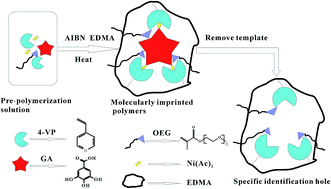Preparation of metallic pivot-based imprinted monoliths with a hydrophilic macromonomer†
Abstract
A new metallic pivot-based molecularly imprinted polymer (MIP) was developed to enhance the imprinting effect of a water-soluble template. The hydrophilic macromonomer oligo(ethyleneglycol) methyl ether methacrylate (OEG), bearing a small oligoethylene glycol side chain, was introduced into the MIP matrix in order to achieve good selectivity and less hydrophobic character. In a ternary porogenic system of dimethyl sulfoxide–dimethylformamide–1-butyl-3-methylimidazolium tetrafluoroborate, an imprinted monolithic column with high porosity and good permeability was synthesized using a mixture of gallic acid (template), 4-vinylpyridine (4-VP), ethylene glycol dimethacrylate, and nickel acetate. The effects of some polymerization variables, such as the ratio of OEG/4-VP and the ratio of template to nickel ions, on the imprinting of the resulting MIP monoliths were systematically investigated. The greatest imprinting factor of 11.53 was achieved on the water compatible MIP monolith with optimized polymerization parameters. In addition, Freundlich analyses indicated that the Ni2+-mediated OEG MIP had homogeneous affinity with a heterogeneity index of 0.87, compared with the Ni2+-mediated OEG-free MIP (0.65) and Ni2+-free OEG MIP (0.67).


 Please wait while we load your content...
Please wait while we load your content...